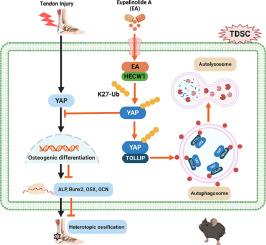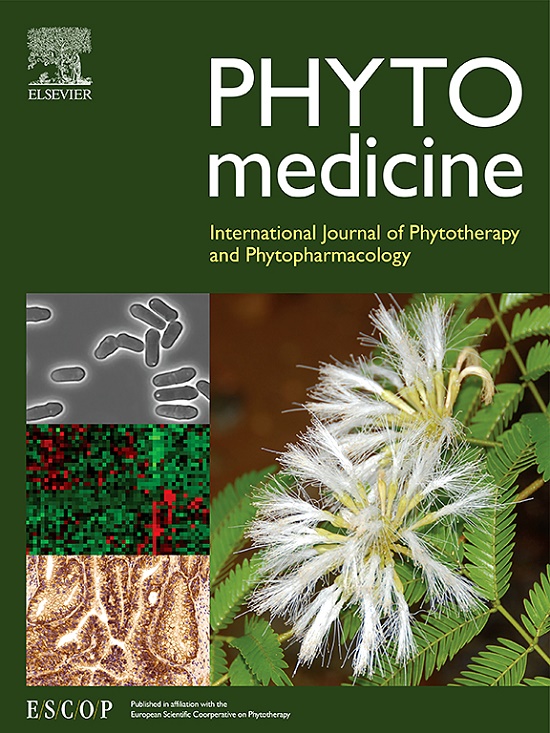Eupalinolide A通过TOLLIP介导的选择性自噬促进YAP降解,从而减轻创伤诱导的小鼠肌腱异位骨化。
IF 6.7
1区 医学
Q1 CHEMISTRY, MEDICINAL
引用次数: 0
摘要
背景:目的:本研究旨在探讨 eupalinolide A(EA)是否能通过抑制 TDSCs 的成骨分化阻止肌腱异位骨化(HO)的进展:方法:在体外研究了EA对TDSCs成骨分化和关键信号通路的影响,以评估其治疗潜力并阐明其潜在的分子机制。此外,还通过局部注射疗法在创伤诱发肌腱HO的小鼠模型中评估了EA的疗效:结果:EA通过靶向YAP在体外明显抑制了TDSCs的成骨分化。具体而言,EA能促进E3泛素连接酶HECW1的招募,从而介导YAP的K27连接多泛素化,导致其通过TOLLIP介导的选择性自噬途径降解。在体内,EA通过抑制YAP通路减轻了创伤引起的肌腱HO:结论:EA可能是治疗创伤性肌腱HO的潜在药物。结论:EA可能是治疗创伤性肌腱HO的潜在药物,通过自噬参与YAP降解的治疗靶点HECW1为减轻创伤性肌腱HO的进展提供了新的治疗途径。本文章由计算机程序翻译,如有差异,请以英文原文为准。

Eupalinolide A attenuates trauma-induced heterotopic ossification of tendon in mice by promoting YAP degradation through TOLLIP-mediated selective autophagy
Background
Inhibiting the aberrant osteogenic differentiation of tendon-derived stem cells (TDSCs) is an effective strategy for treating traumatic heterotopic ossification (HO) in tendons.
Purpose
This study aimed to investigate whether eupalinolide A (EA) could prevent tendon HO progression by suppressing the osteogenic differentiation of TDSCs.
Methods
The effects of EA on osteogenic differentiation and key signaling pathways in TDSCs were examined in vitro to assess its therapeutic potential and elucidate the underlying molecular mechanisms. Furthermore, the therapeutic efficacy of EA was evaluated in a mouse model of trauma-induced tendon HO via local injection therapy.
Results
EA significantly inhibited the osteogenic differentiation of TDSCs by targeting YAP in vitro. Specifically, EA facilitated the recruitment of E3 ubiquitin ligase HECW1, which mediated K27-linked polyubiquitination of YAP, leading to its degradation via the TOLLIP-mediated selective autophagy pathway. In vivo, EA mitigated trauma-induced tendon HO by inhibiting the YAP pathway.
Conclusions
EA could be a potential therapeutic agent for treating traumatic tendon HO. The therapeutic target HECW1 involved in YAP degradation via autophagy presents a new therapeutic avenue to attenuate the progression of traumatic tendon HO.
求助全文
通过发布文献求助,成功后即可免费获取论文全文。
去求助
来源期刊

Phytomedicine
医学-药学
CiteScore
10.30
自引率
5.10%
发文量
670
审稿时长
91 days
期刊介绍:
Phytomedicine is a therapy-oriented journal that publishes innovative studies on the efficacy, safety, quality, and mechanisms of action of specified plant extracts, phytopharmaceuticals, and their isolated constituents. This includes clinical, pharmacological, pharmacokinetic, and toxicological studies of herbal medicinal products, preparations, and purified compounds with defined and consistent quality, ensuring reproducible pharmacological activity. Founded in 1994, Phytomedicine aims to focus and stimulate research in this field and establish internationally accepted scientific standards for pharmacological studies, proof of clinical efficacy, and safety of phytomedicines.
 求助内容:
求助内容: 应助结果提醒方式:
应助结果提醒方式:


